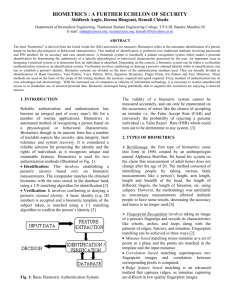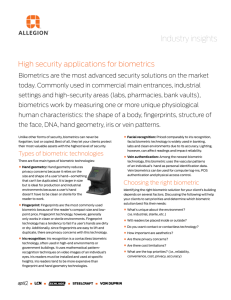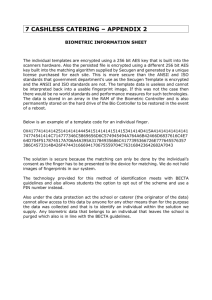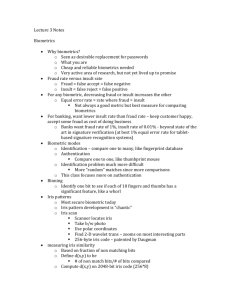Figure 2: Face Recognition
advertisement
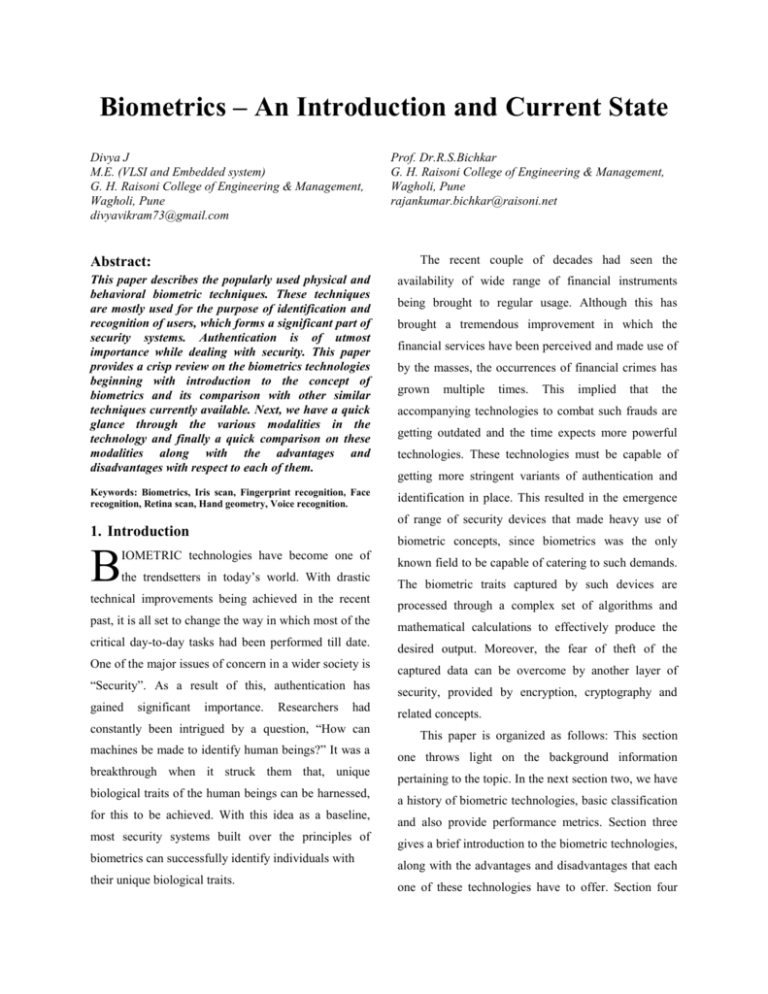
Biometrics – An Introduction and Current State Divya J M.E. (VLSI and Embedded system) G. H. Raisoni College of Engineering & Management, Wagholi, Pune divyavikram73@gmail.com Prof. Dr.R.S.Bichkar G. H. Raisoni College of Engineering & Management, Wagholi, Pune rajankumar.bichkar@raisoni.net The recent couple of decades had seen the Abstract: This paper describes the popularly used physical and behavioral biometric techniques. These techniques are mostly used for the purpose of identification and recognition of users, which forms a significant part of security systems. Authentication is of utmost importance while dealing with security. This paper provides a crisp review on the biometrics technologies beginning with introduction to the concept of biometrics and its comparison with other similar techniques currently available. Next, we have a quick glance through the various modalities in the technology and finally a quick comparison on these modalities along with the advantages and disadvantages with respect to each of them. availability of wide range of financial instruments Keywords: Biometrics, Iris scan, Fingerprint recognition, Face recognition, Retina scan, Hand geometry, Voice recognition. identification in place. This resulted in the emergence being brought to regular usage. Although this has brought a tremendous improvement in which the financial services have been perceived and made use of by the masses, the occurrences of financial crimes has grown multiple times. This implied that the accompanying technologies to combat such frauds are getting outdated and the time expects more powerful technologies. These technologies must be capable of getting more stringent variants of authentication and of range of security devices that made heavy use of 1. Introduction B biometric concepts, since biometrics was the only IOMETRIC technologies have become one of the trendsetters in today’s world. With drastic technical improvements being achieved in the recent past, it is all set to change the way in which most of the critical day-to-day tasks had been performed till date. One of the major issues of concern in a wider society is “Security”. As a result of this, authentication has gained significant importance. Researchers had constantly been intrigued by a question, “How can machines be made to identify human beings?” It was a breakthrough when it struck them that, unique biological traits of the human beings can be harnessed, for this to be achieved. With this idea as a baseline, most security systems built over the principles of biometrics can successfully identify individuals with their unique biological traits. known field to be capable of catering to such demands. The biometric traits captured by such devices are processed through a complex set of algorithms and mathematical calculations to effectively produce the desired output. Moreover, the fear of theft of the captured data can be overcome by another layer of security, provided by encryption, cryptography and related concepts. This paper is organized as follows: This section one throws light on the background information pertaining to the topic. In the next section two, we have a history of biometric technologies, basic classification and also provide performance metrics. Section three gives a brief introduction to the biometric technologies, along with the advantages and disadvantages that each one of these technologies have to offer. Section four takes a dip in the implementation details, by describing 19th century France: Alphonse Bertillon, a member the representation scheme and matching algorithm. of police, invented Anthropometry that used body Based on the factors for an effective biological trait, we measurements to identify criminals. then have a look at the comparison among the Late 19th century Argentina/UK/US: An biometric technologies in section five, which is later Argentine police official was the first person to used in section six to figure out the suitability of these maintain fingerprint files. Sir Francis Galton technologies for certain applications in particular. discovered that fingerprints of two individuals Finally, the last section hints on the scope available for cannot be the same. In 1920s, the U.S. Military and future research in this field. FBI started using fingerprints for identification. Late 20th century: In the last quarter of the Identification Techniques Traditionally, the identification process can be 20thcentury, biometrics accomplished by any of the three techniques; i. Something you possess: Refers to the token based authentication systems using physical objects such as ID cards. The main disadvantage of this based authentication systems. Certain programs/tools are available that can crack the passwords. Also, the person may forget a password/PIN, leading to manual intervention. iii. Something you are: The biometric systems make use of this technique. It efficiently overcomes the disadvantage of the above two techniques, since it makes it nearly impossible to steal the identity. based identification techniques have for rapidly developed. For example, in 1985 it was proposed that irises were unique and first iris recognition algorithm was patented in 1994. The biometric technologies can be broadly approach is that, it can be forged and misused. ii. Something you know: Refers to password/PIN computer-aided classified based on physiological and/or behavioral characteristics, which can be used for identification or verification. The physiological biometrics includes fingerprint, hand geometry, iris, face, retina, etc. whereas the behavioral biometrics includes signature, gait, voice, key stroke, etc. At any given point of time, a biometric device is said to operate in either of the two modes ‘Verification’ or ‘Identification’. The verification (or Authentication) deals with one-to-one comparison of the captured iv. 2. History, classifications, performance criteria of biometrics biometric with an available template. This template is previously enrolled against the person’s record (known individual). Similarly, the identification mode deals The term ‘Biometrics’ is derived from two Greek with words, ‘Bios’ (life) and ‘Metrics’ (measure). The basic biometric image is compared with multiple templates idea of using a person’s bodily features like eyes, face previously enrolled and available in the database. and fingers for his identification was developed over one-to-many comparison, where captured Biometric systems can be evaluated for their time, with the efforts of many people across the globe. performance on the basis of following criteria: 14th century China: In order to distinguish their False Acceptance Rate (FAR) or False Match children from one another, merchants were using their palm and footprints. Rate (FMR): It measures the percentage of invalid input that is erroneously accepted. This also depends Figure 1 shows how a fingerprint scanner records the on the threshold value. identities. False Rejection Rate (FRR) or False Non-Match Rate (FNMR): It measures the percentage of valid input that is erroneously rejected. Receiver/Relative (ROC): The ROC Operating plot Characteristic provides a visual characterization depicting a fair balance between the FAR and FRR. Equal Error Rate (EER) or Crossover Error Rate (CER): It depicts the rate at which rejection errors and acceptance errors are equal. Generally lower Figure1: Fingerprint Recognition EER means more accuracy. Failure to Enroll Rate (FTE or FER): It is the rate at which attempts for the creation of a template from the input turns unsuccessful. It is usually a result of low quality inputs. Failure to Capture Rate (FTC): In case of automatic systems, this gives a probability that the system fails to recognize a correctly presented biometric input. Template Capacity: It provides the highest number of data sets that can be stored in the system. 3.2 Face Recognition Face Recognition is a process of verifying or identifying an individual against a video frame or a digital image from a video source, mostly using a computer application. Typically this is accomplished by comparing facial features from the captured image against the template available in the database as shown in figure 2. Unlike other technologies, face recognition works automatically. Algorithms are developed mainly based on two approaches i.e. either Geometric (feature based) or Photometric (view based).In order that the face recognition system provides the desired output the 3. Encapsulated Technologies 3.1 Fingerprint Recognition acquired image must automatically detect whether a face is present. If yes, locate the face. Finally, the Fingerprint recognition refers to the automated method located faces should be recognizable from general of verifying a match between two or more human perspective (from any pose). fingerprint. The underlying fingerprint matching techniques can be classified as either Minutiae based or Correlation based. In Minutiae based recognition, initially the scanner tries to find the minutiae points on the finger and later maps its relation with the template that is already saved in database. Whereas, correlation based recognition scheme needs a specific location for registration, which may be impacted by image translation and rotation. Figure 2: Face Recognition 3.3 Signature Recognition: places his hand palm down on a metal surface with This technique refers to the recognition of an guidance pegs. These pegs are used to confirm that the individual’s signature using devices. The dynamic fingers are positioned correctly and also verify the signature correct hand position. verification technology provides the capability to identify a computer client, by harnessing the behavioral biometrics of a hand written signature as shown in figure 3.Signatures are widely accepted as a means of authentication, including for commercial and legal transactions. However, studies on signatures have proved that they tend to change as time passes and are significantly influenced by the mental and physical state of the signatories. Also, for a considerable amount Figure 4: Hand Geometry Recognition of people, their signatures vary to some extent. This has been the case even when the signatures marked in a 3.5 Voice recognition: successive manner were considered. Further, there In voice recognition sound sensations of a person exist some professional forgers, whose services could is measured and compared to an existing dataset as be availed to fool the system. shown in figure 5. The person to be identified is usually required to speak a secret code, which facilitate the verification process. An individual’s voice depends on the shape and size of mouth, vocal tracts, lips and nasal cavities that are collectively referred to as appendages. They are used in the synthesis of the sound. Figure 3: Signature Recognition 3.4 Hand geometry: As the name implies, these biometric systems take into account the various measurements from the individual’s hand. Some of these measurements include shape & size of the palm, length & width of the fingers, etc, which is shown in figure 4. It has 3D image of top & sides of hand & fingers collected. From these Figure 5: Speech Recognition images, feature vectors are extracted and compared 3.6 Iris recognition with the dataset feature vector. Even though the This technique is based on the iris of the eye. Iris is a recognition devices are bulky, the identification colored area that surrounds pupil. The iris structure process is performed quickly in seconds. The user contains a highly unique complex pattern. The gray scale image of the eye is obtained and presented to the Schemes and Matching Algorithms are listed below software, which then covers the iris by creating a net of in Table 1: curves. The Iris code is generated based on the darkness of the points that emerges along the lines of Modality Representation Scheme Minutiae Distribution Matching Algorithm String Matching. Face Principal Component Analysis (PCA), Local Feature Analysis(LFA) Euclidean Distance, Bunch graph matching. Hand Geometry Length/width finger/Palm Euclidean Distance Voice Mel-Cepstum Hidden Markov Model, Gaussian Mixture Model Iris Texture Analysis, Key-point Extraction Hamming Distance the software. Figure below shows iris recognition Finger- system. print of Figure 6: Iris Recognition 3.7 Retinal scanning This technique scans the complex network of blood vessels in the retina, which is shown in the figure 7. Table1: Representation scheme and matching algorithms Since the capillaries that supplies blood to the retina is a complex structure, even the identical twins do not 5. Comparison share similar pattern. The scan is performed by directing a beam of low energy light (infrared) into the individual’s eye. This beam detects a standardized path in the retina and discovers a unique pattern. This pattern can then be converted to computer code and can be used as a template for future use. of various biometric technologies 5.1 Comparison based on Performance: Different biometric technologies discussed in Section 3 possess their own set of pros and cons, making it suitable for different set of applications. These technologies can be weighed on the basis of seven factors described below, which can help to determine the most specific areas of application domain. i. Universality: Measures how good is the system in capturing each of the members of the population. ii. Distinctiveness: Measures how well is the system able to distinguish among individuals. iii. Permanence: Measures how well the system remains resistant to biological changes throughout Figure 7: Retina Recognition 4. Representation algorithms: scheme Commonly the enrolled person’s lifetime. and used matching Representation iv. Collectability: Measures how good is the system in acquiring measurements to capture the data. v. Performance: Measures how quickly, accurately that meets all requirements. Table 3 below enlists the and robustly the system collects data and responds. strengths and weakness associated with each of the vi. Acceptability: Measures to what extent are the biometric technologies. It serves as a ready reference to individuals in the relevant population willing to understand accept the system. technologies. the applicability of each of these applications may vii. Circumvention: Measures how difficult would it be to imitate the data in order to manipulate the 6. Applications: Biometric-based system. The comparison among the biometric technologies on authentication typically consist of one or more of the components: workstation & network access, data protection, the basis these factors is described in Table 2 below. application logon, single sign-on, Web security, 5.2 Comparison based on Strengths and weaknesses: transaction security and remote access to resources. The services promised by e-government and e- Even though all biometric systems seem to work in commerce can be achieved successfully only if strong similar manner, the quality of template and the ease of personal authentication procedures are being utilized. enrolment are found to play an important role in overall The benefits of these technologies have already been success. Out of many Characteristics, each biometric proved by the relative financial and non-financial fields system has its own strengths and weaknesses. There are such as secure e-banking, investments and other no particular biometric systems, which can be financial transactions, health and social service and applicable retail sales. to all applications. Based on the application’s usage and the biometric characteristics features, we are able to select a particular biometric The biometrics technologies, we are talking about is a key player in network authentication environment Modality Fingerprint Face Signature Hand Geometry Speaker Recognition Iris Retina Strength ▪ Highly accurate ▪ Very reliable ▪ Consistent ▪ Difficult to duplicate ▪ Readers are economical ▪ Systems require less space ▪ Quick identification ▪ No physical contact - Hygienic ▪ Mass identification possible ▪ Convenient for user ▪ Safe - No privacy concerns ▪ Does not require cooperation of the subject ▪ Wide acceptance (Government, legal) ▪ Fast and simple training ▪ Economical ▪ Low storage requirements ▪ Inconsistent user detectable on enrollment ▪ Convenient acquisition ▪ Good performance ▪ Works in harsh environments ▪ Simple & easy to use ▪ Economical ▪ Unaffected by individual anomalies ▪ Public acceptance ▪ No contact required ▪ Simplest to acquire ▪ Safe - No privacy concerns ▪ Does not require cooperation of the subject ▪ Least obtrusive biometric measure ▪Contact less Process ▪More Secure ▪Highly Reliable. Weakness ▪ Damageable ▪ Scanners can be tricked ▪ User Resistance (Ethical issues) ▪ Privacy concerns of criminal implications ▪ Enrolment issues (cold, wet, desquamation, elder) ▪ Require a large amount of computational resources ▪ Low Performance - lighting, disguise & image resolution ▪ Low Accuracy - expression, viewpoint, etc. ▪ Reliability is slightly lower ▪ Cultural & Religious issues ▪ More expensive & complex ▪ Influenced by physical and emotional conditions ▪ Difficulty for Illiterates ▪ Error Rate is high ▪ Forgeable ▪ Require contact with the writing instrument ▪ Inconsistent (Change over time) ▪ Large size of hand geometry device is needed ▪ Not highly unique ▪ Variable during growth period of children ▪ Difficult to embed in other device ▪ Unsuitable for one-to-many applications ▪ Difficult to control sensor and channel variances ▪ Tiring effect (Ex: teachers, sales person) ▪ Susceptible to noise ▪ Error prone ▪ Distant microphone leads to more errors ▪ Difficult to control sensor and channel variances ▪ May covered by eyelids, eyelashes, reflections from the cornea lens and changes in lighting ▪ Difficult for multiple users of different heights to use in succession. ▪ Significantly more expensive. ▪ Person to be identified must hold the head still and look into the camera. ▪ Modern cataract surgeries can change iris structure. ▪ Alcohol consumption causes deformation of iris pattern. ▪ Scanners can be easily fooled by high quality image of an iris. ▪ Low occurrence of false positives ▪ Very intrusive. Not user friendly. ▪ False negative rate is considerably low ▪ It has the stigma of consumer's thinking it is ▪ Speedy Result potentially harmful to the eye. ▪ Highly reliable ▪ Very expensive. ▪ Accuracy affected by diseases such as cataract. ▪ Accuracy affected by severe astigmatism ▪ Not very user friendly Table 3: Strengths and weakness associated with each of the biometric technologies in large-scale enterprise. When utilized as standalone system or integrated with other technologies such as digital signatures, smart cards and encryption keys, biometrics is highly anticipated to pervade onto each and every aspects of the economy as well as our daily lives. 7. Research Challenges: In the preceding sections, we saw the extent to which Biometric Technologies have grown, to provide effective solutions to some of the most crucial day-today activities. However from the performance aspects, there still exists a descent scope to be explored. A number of challenging research problems mostly related to the matcher design needs to be addressed. Effective representation and matching: One of the biometric system design challenge is to arrive at a representational/invariance model of the identifier that is realistic. The samples used to form these models could have possibly been acquired under inconsistent conditions. Further, the inherent discriminatory information in the signal needs to be formally estimated from the samples. This becomes more difficult in case of large-scale identification systems, due to huge number (in millions) of classes/identifiers. Performance modeling: The inherent signal capacity issue is of utmost complexity. It involves the interaction between the physiological and behavioral attributes as well as the composition of population, at different scales of time, space. Characterizing enhancement: signal quality and A particular biometric must be universal in nature, for it to be effective. In practical use, inconsistent presentation of the signals and adverse signal acquisition conditions often leads to nearly unusable biometric signals. The issue is further affected by the underlying biometric signal varying over time due to aging. Empirical Performance Measurement: Determining reliable techniques to estimate performance is in itself a matter of concern. Besides, the issue related to security, privacy, aliveness and integrity detection needs to be addressed. 8. Conclusion In the recent years biometric authentication has gained exciting technical improvement. It has become an essential part of our life. In this paper we have introduced the concept behind the authentication using biometric, briefly explained the working of different techniques and also estimated the effectiveness by comparing the evaluation metrics. The idea here is not to provide a deep knowledge of different biometric technologies to the reader but to introduce its effectiveness, to show how these technologies differ from each other, applicability and finally some of the research challenges. Bibliography [1] Debnath Bhattacharyya, Rahul Ranjan, Farkhod Alisherov A, Minkyu Choi, "Biometric Authentication: A Review," International Journal of u- and e- Service, Science and Technology, vol. 2, no. 3, p. 16, Sep. 2009. [2] Fahad Al-harby, Rami Qahwaji, mumtaz kamaka, "Secure Biometrics Authentication: A brief review of the Literature," in School of Informatics, Univercity of Bradford, UK, p. 7. [3] Sourav Ganguly, Subhayan Roy Moulick, "A Review On Different Biometric Techniques," International Journal of Engineering Research & Technology (IJERT), vol. 1, no. 5, p. 7, Jul. 2012. [4] Chun-I Fan and Yi-Hui Lin, "Provably Secure Remote Truly Three-Factor Authentication Scheme With Privacy Protection on Biometrics," IEEE Transactions on Information Forensic and security, vol. 4, no. 4, p. 13, Dec. 2009. [5] Anil K. Jain, Fellow, Arun Ross, and Sharath Pankanti, "Biometrics: A Tool for Information Security," IEEE Transactions on Information Forensic and security, vol. 1, no. 2, p. 19, Jun. 2006. [6] Biometrics. Wikipedia, The free encyclopedia. [Online]. http://wikipedia.org/wiki/Biometrics


